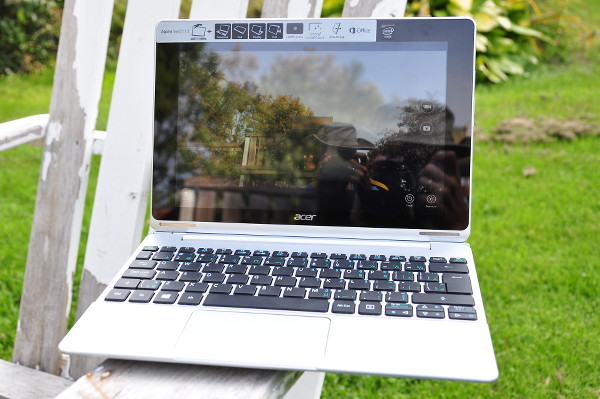One day, I mentioned to someone that I didn’t want to spend money buying a fresh battery for my Lenovo X61T tablet computer. That evening, the battery died completely.
Not long after that, I swung by Best Buy to check out the Surface Pro 3 again. Microsoft has done some nice things there and I would like to show some meaningful support for decisions like the 3:2 screen aspect ratio and strong pressure-sensitive stylus integration.
The cheapest (Core i3) model on display couldn’t keep up with fast pen strokes (such as I use when scribbling notes), and palm rejection failed repeatedly. The Core i5 model seemed to keep up with the pen, but the overall dynamics of the pen (in OneNote) didn’t agree with me, nor did the soft-rubber-on-glass feeling. I’ll keep an open mind on the N-Trig pen, especially if it persists in a Surface Pro 4 or Mini in the medium term.
As much as I’d like to believe the Surface Pro kickstand solves the top-heaviness problem for computers with the primary electronics sitting behind the screen, the kickstand/type cover combo is clearly not going to sit comfortably in my lap. This matters for my use case.
As I was heading out of the store, an Acer Aspire Switch 10 caught my eye. This unit with a 16:10 aspect-ratio display looked very comfortable next to the adjacent Asus with a 16:9 one. Online I discovered that this is a convertible tablet, in the sense that it’s a tablet which docks into a keyboard base, much like the Asus TF101 and successors (and with what superficially seems to be an identical 1280 x 800 10.1-inch IPS screen).
If there isn’t a computer at any price that does everything I want, why not try a really economical one that ticks quite a few of the boxes? On sale at $350 Canadian (plus 13% tax and an eco fee, in the ridiculous way that retailers here are allowed to advertise a price that much smaller than the quantity of money you actually have to hand over to buy a thing), it was worth a try.
Pros:
- I like the screen. I’d like a higher resolution, but at 10 inches diagonal, 1280 x 800 is OK. Vibrant colours. There was a time when a modest machine would meant a TN panel. Glad that’s no longer true!
- Fanless system with solid-state storage: no whining, grinding or whooshing, and no delicate moving parts to fail.
- The touchpad seems pretty responsive and left click by light tap works easily. Two-fingered scrolling is pretty good.
- Nice to have the magnetic hinges and adjustable-angle keyboard to dock the computer in. I guess Microsoft would have shot their marketing strategy in the foot if they’d made a beautiful clamshell dock for the Surface Pro 3 that brought the whole package above the weight of a MacBook Air? Maybe they’ll be secure enough come SP4 time to release such a thing (put a battery in it!)
Cons:
- Frequently the keyboard seems to disconnect and it misses a single character when I begin typing. This is probably the closest thing to a dealbreaker on this whole package.
- This is definitely a lower-powered device. It’s noticeably slow processing JavaScript (TiddlyWiki). Touchscreen response is sometimes slow. Scrolling webpages and, especially, pinching to zoom are laggy. In general performance, my Core 2 Duo Lenovo X61T (running Linux) is definitely snappier.
- I find the keyboard keys a bit stiff (I’m not used to chiclet keyboards)
- Battery life is not great. This isn’t a whole-workday-unplugged computer, by a long shot.
- The sound is a bit quiet on max (software?)
- Need a fn key to access home and end (argh)
- Can’t seem to scale the Windows UI on this computer? Controls on desktop apps are a little small for my fingers even with 1280×800 screen
- Slight play on the hinges
- I miss my trackpoint, but maybe I can get used to using a trackpad? I find text selection a pain with trackpad or touchscreen.
- Touchpad has left and right buttons seamlessly integrated. It’s hard to press one while holding a finger in place on the touchpad.
- No backlit keyboard :(
- 1 GB of RAM (will this matter, given the slow CPU? I won’t be asking it to run Blender, compile or encode anything or do major image processing).
- Not incredibly easy to grip to open up for quick setup.
- The port selection is very limited. Even the dock doesn’t have a full-sized SD slot.
Other notes:
- 32GB storage sounds small but I keep files on external storage (NAS) with a local copy of whatever I want to have available to work on.
- It’s a bit top/back-heavy of course. Really not so bad, especially considering the keyboard doesn’t even have a battery in it to weigh it down.
- The advantage of the 16:10 aspect ratio isn’t totally realized here as the chassis is big enough to accommodate the alternative 1366 x 768 screen. I’d have liked the device to be smaller or the screen to be larger, in the same package. In the case of a larger screen, I’d probably be looking for higher resolution. But now I’m talking myself into more expensive computers!
There would appear to be more cons in my list than pros, but they all have to be taken in the context of a quite inexpensive device. I miss a stylus, and the keyboard not registering the first character typed is a serious ssue. I mean issue. That was not staged.

